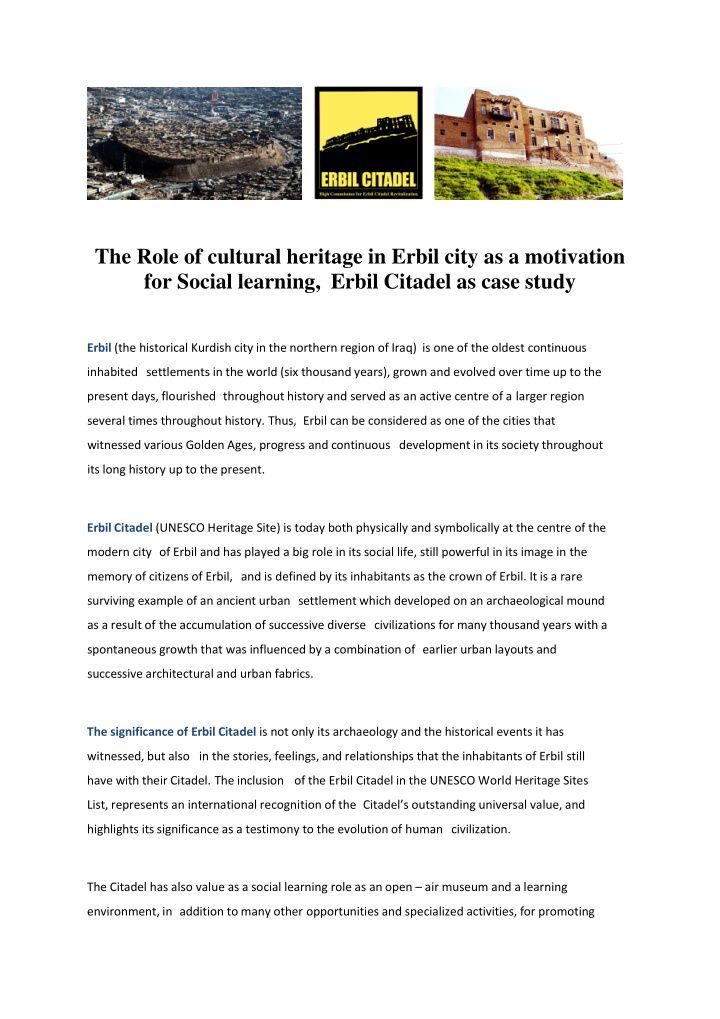



The Role of cultural heritage in Erbil city as a motivation for Social learning, Erbil Citadel as case study Erbil (the historical Kurdish city in the northern region of Iraq) is one of the oldest continuous inhabited settlements in the world (six thousand years), grown and evolved over time up to the present days, flourished throughout history and served as an active centre of a larger region several times throughout history. Thus, Erbil can be considered as one of the cities that witnessed various Golden Ages, progress and continuous development in its society throughout its long history up to the present. Erbil Citadel (UNESCO Heritage Site) is today both physically and symbolically at the centre of the modern city of Erbil and has played a big role in its social life, still powerful in its image in the memory of citizens of Erbil, and is defined by its inhabitants as the crown of Erbil. It is a rare surviving example of an ancient urban settlement which developed on an archaeological mound as a result of the accumulation of successive diverse civilizations for many thousand years with a spontaneous growth that was influenced by a combination of earlier urban layouts and successive architectural and urban fabrics. The significance of Erbil Citadel is not only its archaeology and the historical events it has witnessed, but also in the stories, feelings, and relationships that the inhabitants of Erbil still have with their Citadel. The inclusion of the Erbil Citadel in the UNESCO World Heritage Sites List, represents an international recognition of the Citadel’s outstanding universal value, and highlights its significance as a testimony to the evolution of human civilization. The Citadel has also value as a social learning role as an open – air museum and a learning environment, in addition to many other opportunities and specialized activities, for promoting
local and traditional heritage it represents in interpreting the culture of the region and the city of Erbil. All these activities play a role in educating society, especially younger generations and school students, who make up the larger proportion of overall visitors, and accordingly providing and updating them with information in a friendly manner within a pleasant environment is a main objective for making the Citadel a pleasant learning environment. Erbil Citadel Revitalization Project The Kurdistan Regional Government (KRG) initiated a project and set up a dedicated body (the High Commission for Erbil Citadel Revitalization) to develop and revitalize the Citadel as a living active historical, cultural and recreational center, in the heart of the modern Erbil City. Since 2010, Comprehensive and strategic plans were developed for revitalizing the Citadel by applying conservation and management measures in line with international standards, while enhancing national capacities in the field of heritage conservation, management and interpretation through the High Commission for Erbil Citadel (HCECR) and UNESCO Iraq Office. The vision for Erbil Citadel is to become a national treasure, internationally recognized as a symbol of the development of human culture and urban civilization, but also the living, dynamic and self- sustaining historic centre of the modern City of Erbil and the Kurdistan Region of Iraq, conserved to international standards for future generations and interpreted for visitors from inside and outside Iraq. School Visit School Visit “Unite 4 Peace” Kurdish Textile Museum Event
The PowerPoint presentation starts with a brief description and overview on Erbil City and its learning development perspectives, exploring general information, geographical data, historical background, and the most notable golden ages and events within its long history. The presentation will focus on Erbil Citadel as a case study in detail, demonstrating how the present- day Citadel is becoming a site that has a potential learning capacity for the modern City of Erbil, showing its evolution up to the present days as a settlement with continuing role in social learning practices along its long history. The presentation describes the evolution of Erbil Citadel as a historical landmark within the heart of modern Erbil City and how it developed to an open air museum and learning environment, exploring its role as a dynamic learning tool for interpreting the history and the culture of the City and the region, providing information for visitors, especially the young generations, in a pleasant atmosphere and friendly welcoming environment, making the Citadel a positive learning environment. The PowerPoint Presentation will cover the following main themes: 1. Erbil City overview (brief description, location, figures and statistics) 2. Historical background, golden ages and key events in history. 3. Schools and education in Erbil city (historical background and contemporary overview ) 4. Erbil Citadel (significance, architecture, urban fabric and archeological investigation) 5. Erbil Citadel revitalization project (overview, vision, management and achievements. 6. Management perspectives, stakeholders, UNESCO and other parties. 7. The role of Erbil Citadel as cultural learning environment and open air museum. 8. Erbil Citadel Cultural activities (museums, exhibitions, seminars, lectures). 9. Visitors to the Citadel, Schools and Universities, delegations and tourists. 10. Events, national ceremonies, social gathering and other activities in the citadel. In addition to the presentation there will be other supporting materials and documents, including a book (Highlights of Erbil Citadel), 4 brochures (leaflets), 4 posters, 2 short films or videos. The session ends with open discussions through raising questions on different topics related to the presented case and the future development of Erbil as a cultural Learning City.
Issues for discussion: 1. How can Erbil city be developed to become a learning city? 2. How Erbil city has the potential to meet PASCAL objectives? 3. In what ways can-Erbil citadel site can function as an open air museum and learning environment? 4. Erbil citadel can host and act as motivation for social learning activities. Prepared by Dara al Yaqoobi , Head of the High Commission for Erbil Citadel Revitalization (HCECR), Erbil Dr. Mahmood Khayat , Head of Architectural Department, University of Salahaddin, Erbil Tahir Abdulla Osman , Deputy Governor, Erbil Governorate, Kurdistan Region
Recommend
More recommend